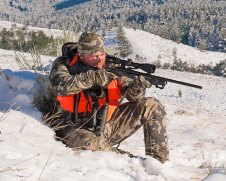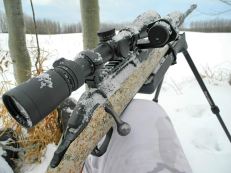When that tingling you feel is not just the excitement of the hunt, but more like the onset of frostbite, it may be time to start thinking about your cold weather shooting routine.
For those of us that live in the north, dealing with colder temperatures is just a part of life. You get used to it and adjust accordingly. If you do shoot during the winter months, there are some things that you’ll have to consider.
Now there is a distinction to be made between feeling brisk or chilly and being really cold cold. As soon as the temperature drops sub-zero, it can  play havoc on your equipment and ballistics. If you’re simply going to the range it’s one thing. You can just pack it up if things get uncomfortable or if you experience issues with your weapon. For military exercises or hunting excursions, you’ll want to be better prepared. If you and your firearm are outdoors for extended periods of time in extreme cold (and in potentially inclement weather as well), the last thing you’ll want is a mechanical failure or a missed critical shot.
play havoc on your equipment and ballistics. If you’re simply going to the range it’s one thing. You can just pack it up if things get uncomfortable or if you experience issues with your weapon. For military exercises or hunting excursions, you’ll want to be better prepared. If you and your firearm are outdoors for extended periods of time in extreme cold (and in potentially inclement weather as well), the last thing you’ll want is a mechanical failure or a missed critical shot.
There is actually a good amount of data on this subject, with a lot of it coming by way of military experience and research. There are also great resources and insights to be found from hunters who routinely trip to the north. A lot of it is common sense, but there are still rookie mistakes to be made.
Cleaning & Lubrication
In the old days, the use of oil-based lubricants was problematic due to the fact that they would get sticky in the cold and would potentially gum-up your firing mechanism. That, coupled with just a little dirt or debris, could cause real issues out in the field. From slower operation to complete failure,  it was clearly less than ideal.
it was clearly less than ideal.
There was a general rule-of-thumb at one point (which some still subscribe to) that completely degreasing the bore and all moving parts was the way to go. That shooting dry in extreme cold was the only solution. Luckily, modern synthetic lubricants don’t have the same issues when it comes to becoming more viscous, and they can be used with confidence. Breakfree CLP® is a good example. You’ll still want to keep it to a minimum though (and be sure that your weapon is clean of course).
Keep Things Dry
As in most situations, being cold and wet is never good. Moisture can easily find its way into your firearm in the form of rain, snow, ice or condensation, and when it freezes, that’s where the trouble starts. It only takes a small amount of water to freeze a firing pin into place or cause a polymer part to snap.
It is hard to keep your gear dry when the weather is nasty or if you’re making your way through dense, snow-laden brush. Some hunters get into the habit of covering their gun with a bag (or something similar) until they’re ready to use it. That may seem a little cumbersome or potentially time  consuming – at the very least, the end of the barrel should be covered though. This is a very common practice and is a simple way to keep snow, water and debris out of your gun. There are specially made muzzle covers available, but a lot of shooters go with something simpler like a strip of electrical tape, a band-aid, a rubber or nitrile first aid finger cot or a condom with a rubber band. The good thing is that you can fire right through these things with no affect on your shot. Be sure to keep some of this spare material in your pack.
consuming – at the very least, the end of the barrel should be covered though. This is a very common practice and is a simple way to keep snow, water and debris out of your gun. There are specially made muzzle covers available, but a lot of shooters go with something simpler like a strip of electrical tape, a band-aid, a rubber or nitrile first aid finger cot or a condom with a rubber band. The good thing is that you can fire right through these things with no affect on your shot. Be sure to keep some of this spare material in your pack.
One of the sneakiest ways that water gets into your gun is through the condensation that builds up when you move between warm and cold environments. When you head back into a toasty house, tent or truck, a thin film of moisture will build-up on the interior and exterior of the gun and once you go back outdoors, this water will freeze.
Your best bet is to just leave your gun outdoors and keep it dry. The consistency of the temperature will help to eliminate the issue. Keeping a cleaning kit and some lock deicer handy can help if you run into a problem in the field. You can also bring a back-up gun on the off chance that something goes sideways. Can’t hurt and it may save your trip.
Protect Those Hands
Keeping your fingers warm and comfortable while shooting might seem self-evident, but it often gets overlooked. It’s not so much the time in-between the shots you take (eg. traveling or waiting), but more the time your hands may be exposed for your set-up and the execution of the shot. In extreme cold, it doesn’t take long at all for you to lose dexterity and your ability to feel the trigger. This can really be highlighted if your trigger is particularly sensitive and you happen to squeeze-off an errant shot before you’re ready.
There are many different products available that can help suit your individual preferences. Obviously you can’t wear anything too bulky, but some have found that a thinner liner type of glove can work well under a mitt or thicker glove that can be pulled off. There are also many specialty and finger-free items on the market, hand warmer packs and battery powered gloves and mitts that also work well in these situations.
Sighting, Trajectory & Ballistics
With the understanding that cold air is denser and that it will affect your accuracy, you’ll definitely have to make some adjustments. The cold will absolutely slow down your bullet speed, causing it to drop, make it more susceptible to wind drift and will decrease the energy at impact. We’ll get into more detail on this subject in a follow-up post, but here are a few notes to consider for now.
 Be sure to zero your optics at the conditions that you’re shooting in to help improve overall accuracy.
Be sure to zero your optics at the conditions that you’re shooting in to help improve overall accuracy.
Make yourself familiar with the data and charts available for trajectory in cold conditions. It can be surprising just how much drop and drift can occur.
You may want to adjust your optics to account for your thicker outerwear, as it will tend to push your scope away and change the eye relief. A shorter seasonal stock can help in some cases.
Your target distance can be a factor in harsher conditions (not a surprise), so you may want to think about how ambitious you want to get with anything beyond 200 or 300 yards. Some hunters will go with higher velocity ammo to help account for the cold environment, but in any case, you might want to field test your loads if you’re serious about hitting what you aim at.
Don’t underestimate what the cold can do to your guns and your experiences outdoors. No one wants to have a trip cut short or miss an opportunity to make a memorable shot. Think ahead and plan for the worst in extreme conditions.
Sign up for K-Var’s weekly newsletter and discounts here.

I wear a shooting muff with ,chemical heat pack,thin gloves and just remove my hand when ready to shoot.
Alternatively you may be able to find larger than standard trigger guard[military used them during the wars] that safety allow glove finger into the guard,additionally there have been some trigger mounted levers that extend out of the trigger guard[perhaps could even use with mittens[I keep a heat pack in any gloves or mittens].20*F used to be warm-NO MORE!
We used to use a plain #1 or #2 pencil[graphite] to lube the action
Thanks for the added tips!